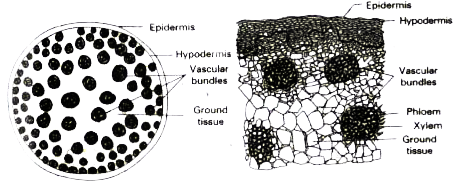Describe the T.S of a Monocot stem . Solution in Telugu
The structure of monocot stem can be understood well by observing the T.S of stem of Zea mays .It shows 4 distinct parts ., namely 1 . Epidermis , 2. Hypodermis 3. Ground tissue and 4 . Vascular bundles .
(1) Epidermis : It is the outermost layer composed of rectangular or tubular living cells arranged closely and compactly without intercellular spaces . The cells contain vacuolated protoplasts with a single nucleus but chloroplasts are absent . A waxy layer called .cuticle. is deposited on the external surface of the epidermis . Cuticle prevents the evaporation of water from the plant body . Trichomes are absent Numerous stomata are found in the epidermis through which exchange of gases occurs .
Epidermis gives protection to the inner tissues , helps in the exchange of gases and also prevents the evaporation of water .
Hypodermis : A distinct cortex is absent in Monocot stems . However a thick walled hypodermis is found beneath the epidermis .The cells of hypodermis are sclerenchymatous and are arranged compactly in 3-4 rows, without any intercellular spaces. It gives machanical strength of the stem .
Ground tissue : A major part of the stem is formed by an extensive soft , parencymatous tissue called the ground tissue . The peripheral layer consists of smaller cells while the inner layers show bigger cells . The cells of peripheral layers are chlorenchymatous and are connected with a assimilation of food materials .the inner layers of cells are concerned with storage of food materials . In monocot stem endodermis is absent .
Vascular bundles : Numerous vascular bundles are found scattered irregularly in the ground tissue . This kind of arrangement is called .atactostele. .It is considered an on advanced character . The inner vascular bundles are bigger in size and far apart from one another . The outer vascular bundles are smaller and are close to one another and found in one or teo circles .
Each vascular bundle is oval in shape and shows xylem and phloem together on the same radius . There is no cambium between xylem and phloem at the upper side of the vascular bundle . Each vascular bundle is enchosed by a sheath of sclenrenchymatous fibres . Hence it is called fibro vascular bundle .
Xylem consists of tracids , vessels ,fibres and parenchyma . Xylem vessels are few in number (4) and are arranged in "Y" shape . one or two protoxylem cells are crushed forming lysigeneous cavity called protoxylem lacunae which store water pholem consists of sieve tubes and companion cells . Phloem parenchyma is absent Medulla , Medullary rays and pericycle are also absent .

Topper's Solved these Questions
- HISTOLOGY AND ANATOMY OF FLOWERING PLANTS Book:VIKRAM PUBLICATION ( ANDHRA PUBLICATION)Chapter:HISTOLOGY AND ANATOMY OF FLOWERING PLANTS Exercise:TEXTUAL EXERCISES
Explore 3 Videos
- HISTOLOGY AND ANATOMY OF FLOWERING PLANTS Book:VIKRAM PUBLICATION ( ANDHRA PUBLICATION)Chapter:HISTOLOGY AND ANATOMY OF FLOWERING PLANTS Exercise:IMPORTANT QUESTIONS
Explore 7 Videos
- HISTOLOGY AND ANATOMY OF FLOWERING PLANTS Book:VIKRAM PUBLICATION ( ANDHRA PUBLICATION)Chapter:HISTOLOGY AND ANATOMY OF FLOWERING PLANTS Exercise: SHORT ANSWER TYPE QUESTIONS
Explore 10 Videos
- ECOLOGY AND ENVIRONMENT Book:VIKRAM PUBLICATION ( ANDHRA PUBLICATION)Chapter:ECOLOGY AND ENVIRONMENT Exercise:IMPORTANT QUESTIONS
Explore 45 Videos
- LOCOMOTION AND REPRODUCTION IN PROTOZOABook:VIKRAM PUBLICATION ( ANDHRA PUBLICATION)Chapter:LOCOMOTION AND REPRODUCTION IN PROTOZOAExercise:Important Questions
Explore 13 Videos
Similar Questions
Name the various kinds of cell layers which constitute the bark .
View SolutionWhy are xylem and phloem called complex tissues?
View SolutionState the location and function of different types of meristem.
View SolutionDefine the term "ecology" and its branches.
View SolutionList any two differences between a flagellum and a cilium.
View SolutionDescribe the vascular bundles of monocot stem.
View SolutionDescribe the internal structure of a monocot stem.
View SolutionCompare T.S. of monocot and dicot stem with the help of well labelled diagrams only.
View SolutionDescribe internal structure of monocot stem.
View SolutionDescribe the T.S. of dicot stem.
View SolutionWith the help of a neat labelled diagram, describe the T.S. of a monocot root.
View SolutionWith the help of a neat labelled diagram, describe T.S. of dicot stem (sunflower).
View SolutionDraw and label a part of T.S. of a monocot stem. Explain various tissues present in it.
View SolutionDescribe the T.S of a dicot stem .
View SolutionDescribe the anatomy of monocot stem.
View Solution